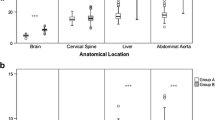Abstract
The objective of this study was to compare two different scanning protocols in patients suspected to have multiple trauma using multidetector 16-row computed tomography (CT) to better define scanning time, imaging quality and radiation exposure. Forty-six patients, between March 2004 and March 2005, with suspected multiple trauma (cerebral, spine, chest, abdominal and pelvis) were evaluated with two different protocols: Protocol “A” 26 patients; Protocol “B” 20 patients. Protocol A consists of a single-pass continuous whole-body acquisition (from vertex to pubic symphysis), whereas Protocol B of conventional segmented acquisition with scanning of body segments individually. Both protocols were performed using a multidetector 16-rows CT (Light-Speed 16, General Electric Medical System, Milwaukee, WI, USA) with the same technical factors. Radiation dose was evaluated in two ways: computer tomography dose index (CTDI) = dose measured in central and peripheral region of the subjects as a direct result of a CT section acquisition of T millimeters thick (independent from the two protocols) and dose length product (DLP) = total dose deposited over the length of the acquisition (dependent from the two protocols). Image quality was rated according to the following scores: 1, excellent; 2, good; 3, satisfactory; 4, moderate and 5, poor. The results were compared using Wilcoxon’s test to identify significant difference in terms of image quality, scanning time, radiation exposure and presence of artifacts, assuming significance at a p value of <0.05. In the single-pass scanning, DLP was 2.671 mGy × cm and a total scan time of 35 s. In whole-body protocols, we have seen artifacts due to arm adduction in thorax and less image quality in brain. In the conventional segmented study, DLP was 3.217 mGy × cm and a total scan time of 65 s; this protocol offered less extraction capabilities of off-axial on focused images of the entire spine, aorta, facial bones or hip without rescanning. Protocol A revealed a significant decrease in scan time (35 vs 65 min, p < 0.05), time in the CT examination room (21.7 vs 31.6 min.; p < 0.05), and final image analysis (83.7 vs 102.9 min; p < 0.05) and radiation dose compared to protocol B (p < 0.05). No significant difference was found for patient transport time, image reconstruction time and imaging quality. Reconstruction and isotropic reformation of axial image acquired by whole-body, single-pass protocols due to entire spine evaluation, aortic and splanchnic CT angiography eliminate additional studies. The whole-body, single-pass protocols, compared with segmented acquisitions protocols, resulted in a reduced total radiation dose without relevant loss of diagnostic image information.





Similar content being viewed by others
References
Cody DD (2002) AAPM/RSNA physics tutorial for residents: topics in CT. Image processing in CT. Radiographics 22:1255–1268
Dawson P, Lees WR (2001) Multi-slice technology in computed tomography. Clin Radiol 56:302–309
Brenner DJ, Elliston CD (2004) Estimated radiation risks potentially associated with full-body CT screening. Radiology 232:735–738
Hauser H, Bohndorf K (1998) Radiologic emergency management in multiple trauma cases. Radiologe 38:637–644 (in German)
Hu H, He HD, Foley WD, Fox SH (2000) Four multidetector-row helical CT: image quality and volume coverage speed. Radiology 215:55–62
Kelly DM, Hasegawa I, Borders R, Hatabu H, Boiselle PM (2004) High-resolution CT using MDCT: comparison of degree of motion artifact between volumetric and axial methods. Am J Roentgenol 182:757–759
Klingenbeck-Regn K, Schaller S, Flohr T, Ohnesorge B, Kopp AF, Baum U (1999) Subsecond multi-slice computed tomography: basics and applications. Eur J Radiol 31:110–124
Kloppel R, Schreiter D, Dietrich J, Josten C, Kahn T (2002) Early clinical management after polytrauma with 1 and 4 slice spiral CT. Radiologe 42:541–546 (in German)
Lee EY, Siegel MJ, Hildebolt CF, Gutierrez FR, Bhalla S, Fallah JH (2004) MDCT evaluation of thoracic aortic anomalies in pediatric patients and young adults: comparison of axial, multiplanar, and 3D images. Am J Roentgenol 182:777–784
Leidner B, Adiels M, Aspelin P, Gullstrand P, Wallen S (1998) Standardized CT examination of the multitraumatized patient. Eur Radiol 8:1630–1638
Linsenmaier U, Krotz M, Hauser H et al (2002) Whole-body computed tomography in polytrauma: techniques and management. Eur Radiol 12:1728–1740
Mahesh M (2002) Search for isotropic resolution in CT from conventional through multiple-row detector. Radiographics 22:949–962
Novelline RA, Rhea JT, Rao PM, Stuk JL (1999) Helical CT in emergency radiology. Radiology 213:321–339
Nunez DB Jr, Ledbetter MS, Farrell L (2002) Dedicated CT scanner in an emergency department: quantification of factors that contribute to lack of use. Am J Roentgenol 179:859–862
Philipp MO, Kubin K, Hormann M, Metz VM (2003) Radiological emergency room management with emphasis on multidetector-row CT. Eur J Radiol 48:2–4
Philipp MO, Kubin K, Mang T, Hormann M, Metz VM (2003) Three-dimensional volume rendering of multidetector-row CT data: applicable for emergency radiology. Eur J Radiol 48:33–38
Prokop M (2003) General principles of MDCT. Eur J Radiol 45:4–10
Prokop M (2003) Multislice CT: technical principles and future trends. Eur Radiol 13(Suppl 5):M3–M13
Ptak T, Rhea JT, Novelline RA (2001) Experience with a continuous single-pass whole-body multidetector protocol for trauma: the three minute multiple trauma scan. Emerg Radiol 8:250–256
Ptak T, Rhea JT, Novelline RA (2003) Radiation dose is reduced with a single-pass whole-body multi-detector row CT trauma protocol compared with a conventional segmented method: initial experience. Radiology 229:902–905
Roos JE, Desbiolles LM, Willmann JK, Weishaupt D, Marincek B, Hilfiker PR (2002) Multidetector-row helical CT: analysis of time management and workflow. Eur Radiol 12:680–685
Author information
Authors and Affiliations
Corresponding author
Rights and permissions
About this article
Cite this article
Fanucci, E., Fiaschetti, V., Rotili, A. et al. Whole body 16-row multislice CT in emergency room: effects of different protocols on scanning time, image quality and radiation exposure. Emerg Radiol 13, 251–257 (2007). https://doi.org/10.1007/s10140-006-0554-0
Received:
Accepted:
Published:
Issue Date:
DOI: https://doi.org/10.1007/s10140-006-0554-0




